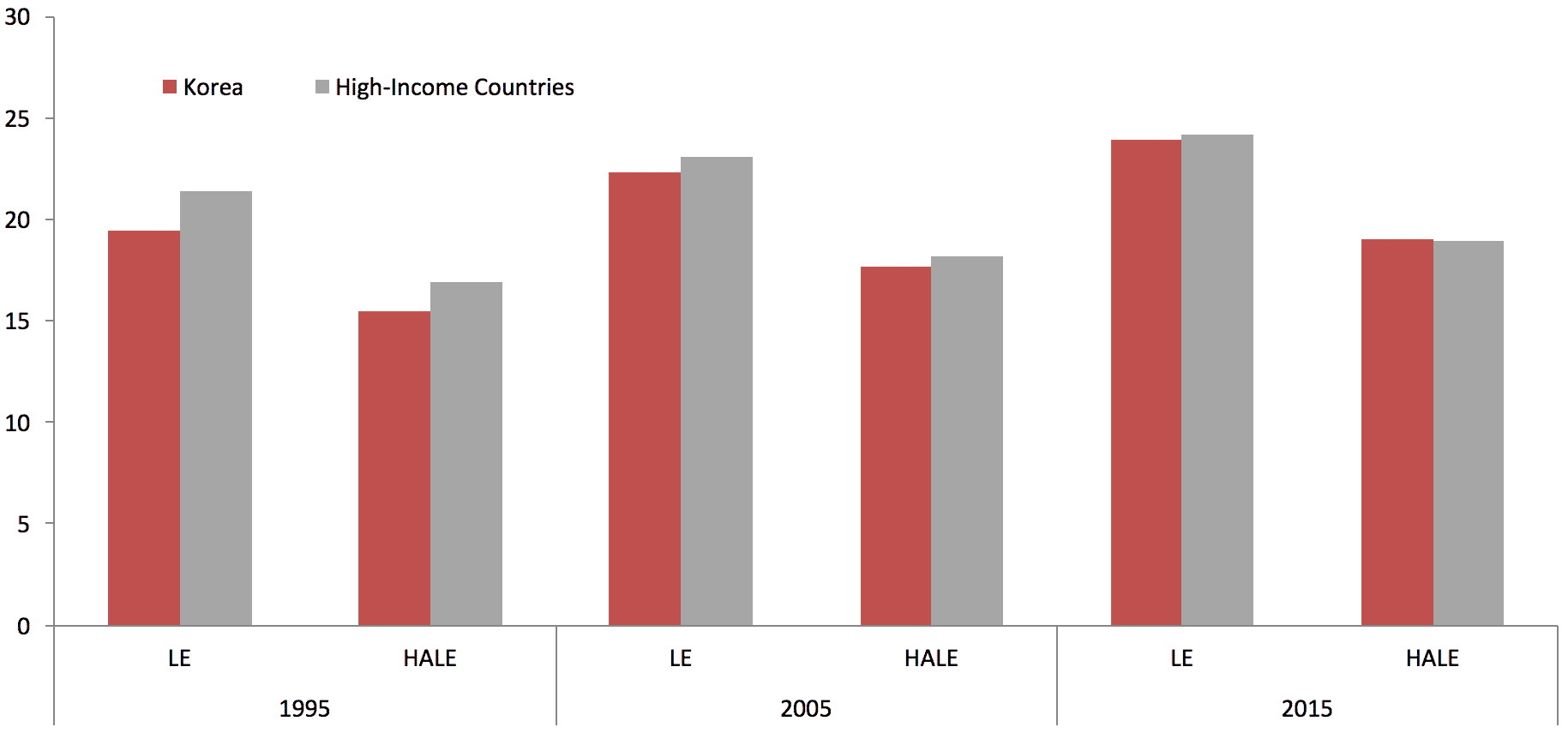Korea is among the most rapidly aging high-income countries, and it is projected to overtake Japan to become the most aged country in the world in 2060. The fast aging of the Korean population is partly a result of the country’s two baby booms, which emerged between 1955 and 1963 and between 1968 and 1974. The aging baby boomers tend to be better educated and wealthier than previous generations, representing an enormous economic and business opportunity for the country, particularly in terms of labor participation and technology adoption.
In light of this demographic transformation, the Korean government has increased its efforts to integrate aging-related policies into its broader economic and social-development agenda. While some of these efforts have been successful, others have caused notable controversy – particularly efforts to capitalize on productive potential in the older population. Policies aimed at extending older adults’ work life have intensified inter-generational tension as well as controversy over the net impact on older adults’ well-being.
To meet growing demand for healthcare by the aging population, the government took action to reform the long-term-care insurance system in 2016, with a focus on improving administrative efficiency and service coverage of the system. It is also seeking to take advantage of the country’s advanced IT infrastructure to develop digital healthcare services and, so far, has received a positive response, particularly from large companies.
Number and Share of Population Age 65 or Older
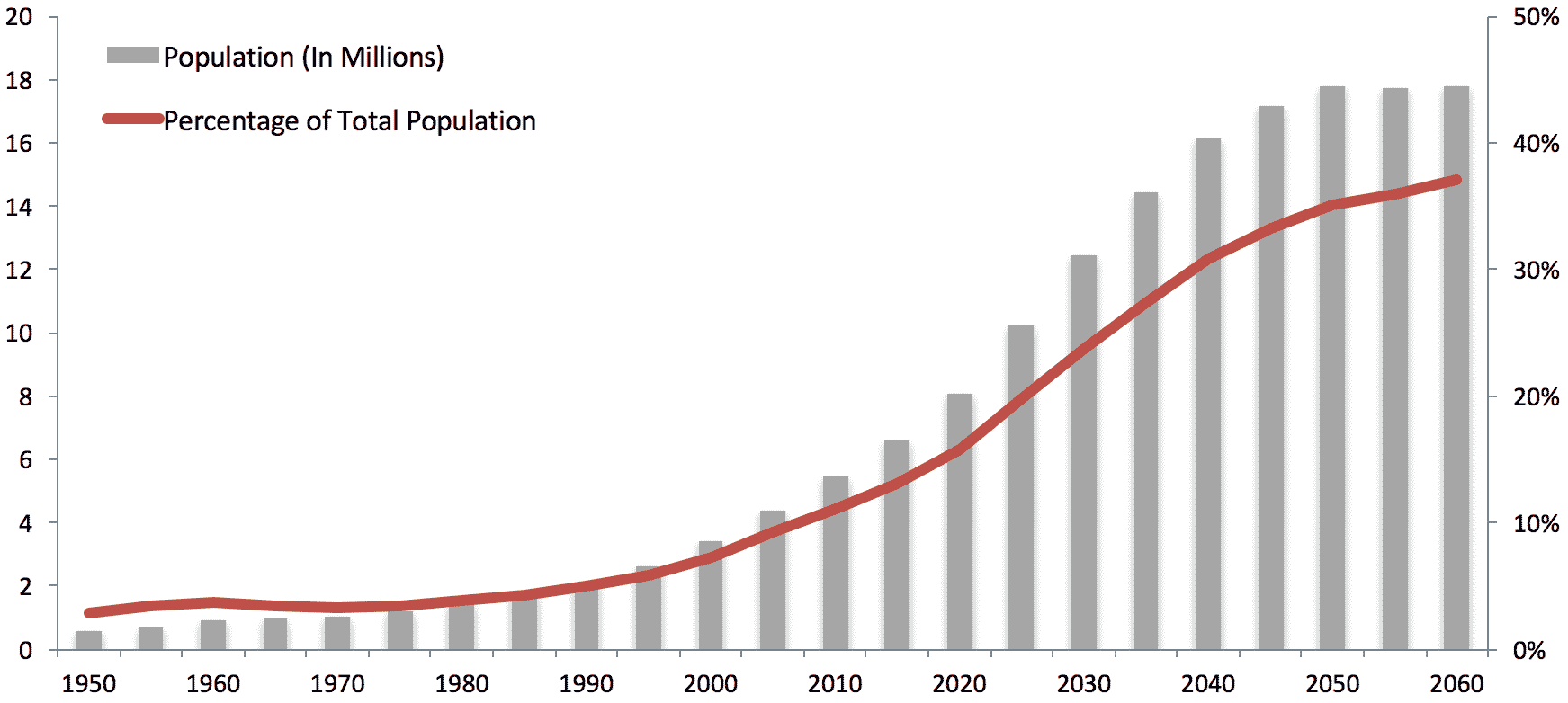
In 2017, Korea is expected to become an “aged” society, having crossed the UN threshold of 14 percent of its population over age 65. It will have taken only 18 years to complete the transition from an “aging” society, less time than any current “aged society.”
Source: UN Population Division

Community Social Infrastructure
Korean society has been rapidly shifting away from its traditional extended family structure to nuclear families, resulting in an increase in the share of older people living independently and contributing to their social isolation and risk of suicide. The government has been responding with programs, including older-age volunteering activities and suicide-prevention programs, with positive results.
Although still the highest within the OECD, from 2011 through 2015, the older adult suicide rate in Korea dropped by more than 25 percent to 58.6 suicides per 100,000 people, largely thanks to the government’s suicide-prevention efforts.
Living Arrangement of People Age 65 and Older
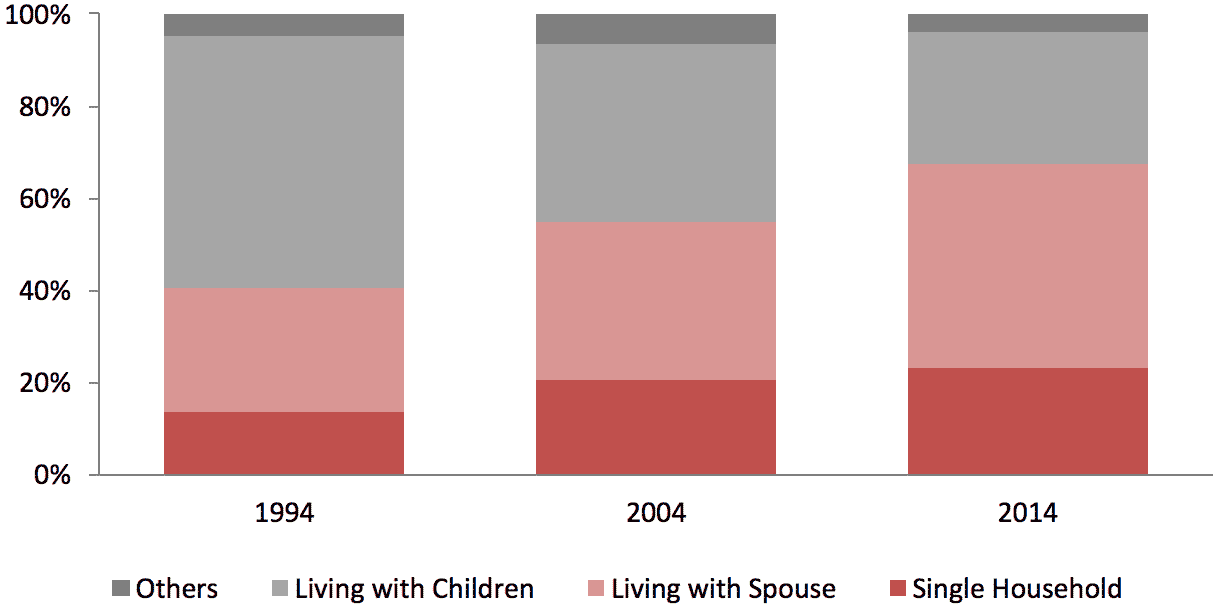
The number of older Koreans who live independently has grown rapidly over the past two decades. While just 40 percent of older adults lived alone or with a spouse as of 1994, 20 years later this had grown by more than two-thirds, reaching 68 percent.
Source: Korea Institute for Health and Social Affair
To support older adults’ social engagement, the Korean government has been working to provide age-friendly physical infrastructure and has made significant progress in areas like transportation accessibility, but challenges remain in access to affordable, age-friendly housing. Some municipalities have taken the initiative to build age-friendly communities to accommodate a healthy, active aging population, led by city of Seoul.
Seoul’s Age-Friendly Initiative
In 2013, Seoul introduced the Age-Friendly Initiative, a comprehensive set of measures, which range from fostering a comfortable living environment and a vibrant recreational culture to supporting healthy aging and employment. Seoul’s initiative has a unique el ement of extending the focus beyond the World Health Organization’s age-friendly guidelines and toward people in their middle years, in the hope of better preparing the future older population. Since 2014, the municipality has operated an online portal called “50+ Seoul,” which provides information on a wide range of topics, including community services, cultural events, education and training, and job and volunteer opportunities to support various aspects of their life.
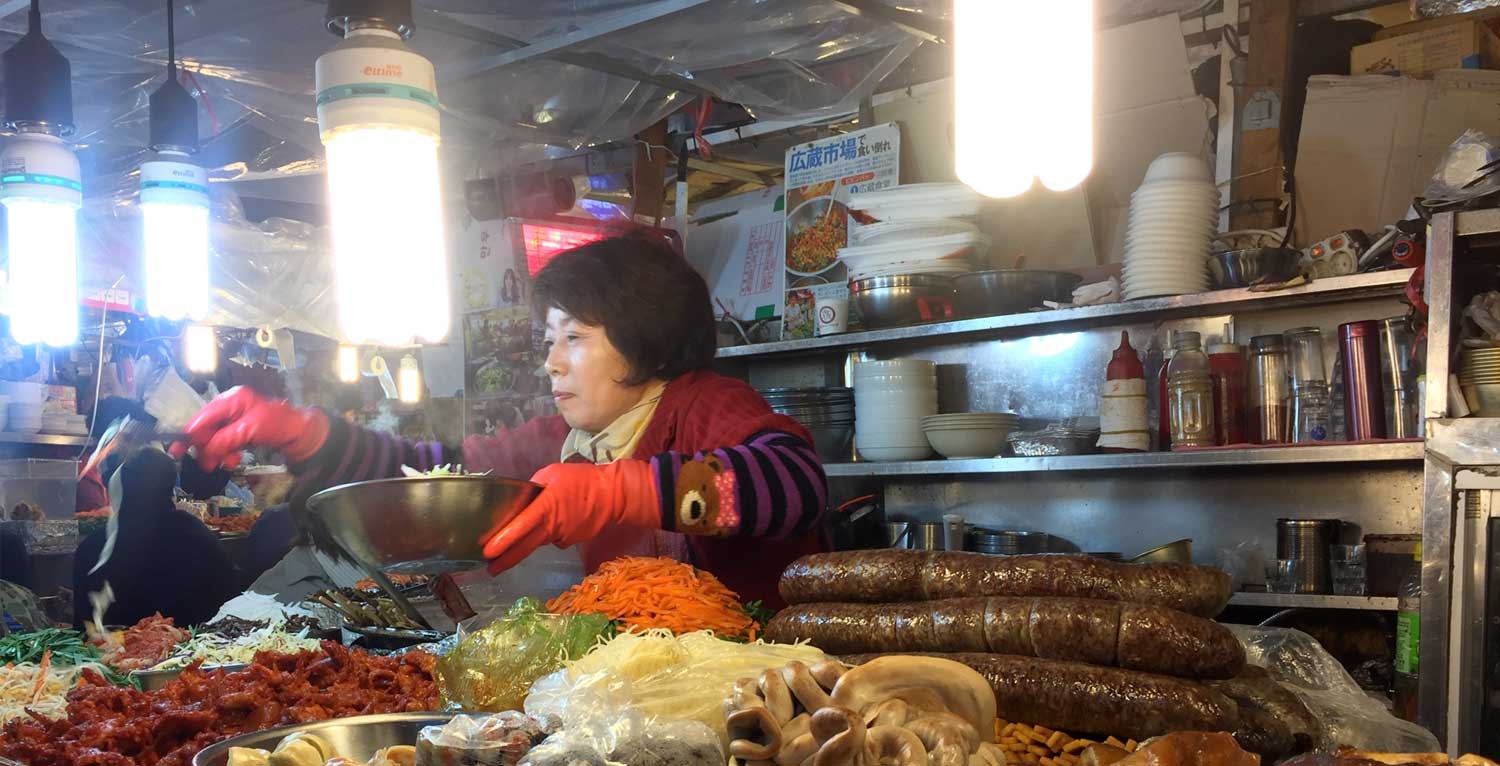
Productive Opportunity
The Korean government has been seeking to facilitate economic participation of both current and future retirees. To address the needs of today’s older population, whose high level of interest in employment is driven mainly by poverty, the government has augmented assistance to improve their skills and employability. Meanwhile, in the pursuit of fiscal sustainability of the public pension system, the government has been working to extend the retirement age to allow older people who are about to retire to stay in the workforce, including the promotion of a controversial wage peak system. These policies have been met with criticism, due to a widely held zero-sum perception that older workers’ participation in the workforce takes away job opportunities for younger people. However, given the educational attainment of baby boomers, the government’s effort to increase older adults’ participation in the workforce could yield positive results for the economy as the society ages.
Wage Peak System
Seeking to retain older adults in the workforce, the Korean government introduced structural wage reform and promoted a wage peak system starting in 2015. The system is designed to allow workers over a certain age (usually retirement age minus five to seven years) to get a gradual salary reduction in exchange for extending their employment to age 60 or beyond. By promoting this system, the government is seeking to reduce the cost for employers of retaining older workers –which traditionally is relatively high due to the prevalent seniority-based wage system. More than 60 percent of government agencies and state-owned enterprises have implemented the system. The adoption rate among the private sector is lower but has been increasing.While the wage peak system would provide greater job security for older employees, it has been criticized by some as negatively impacting older adults’ well-being.
Poverty and Labor Force Participation Rates People Age 65 or Older
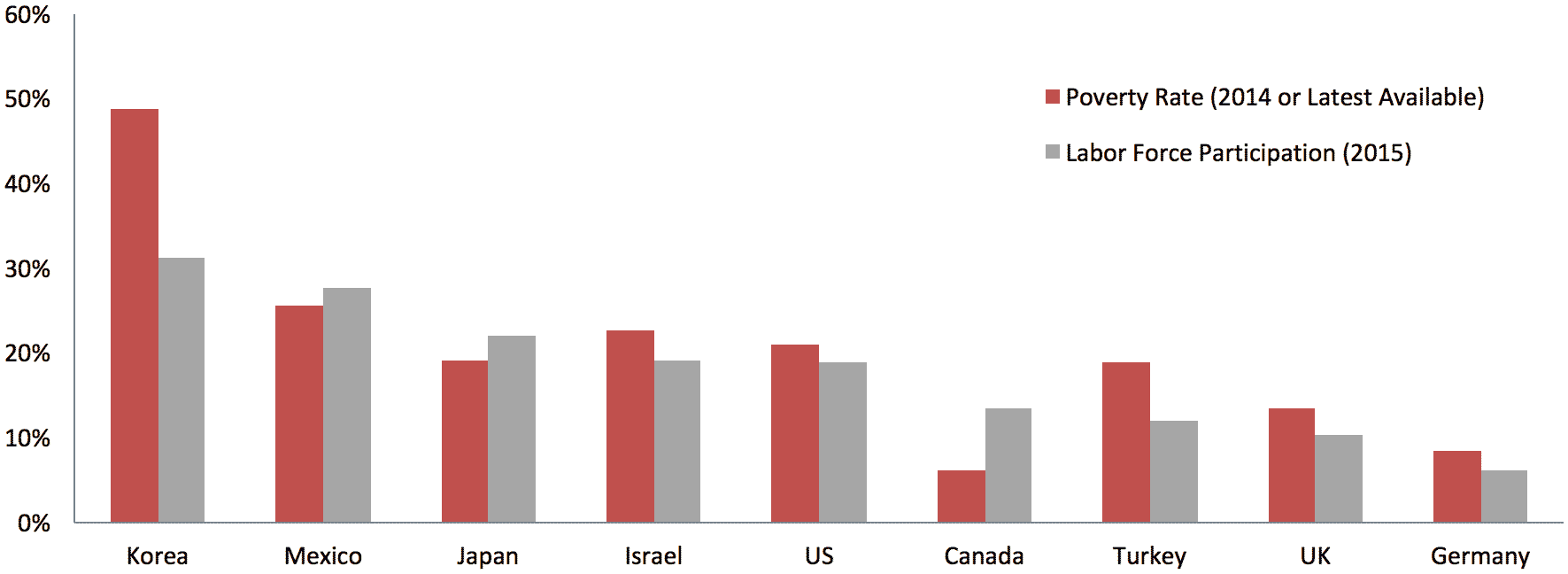
Korea has the highest labor force participation rate of people age 65 and older among OECD countries after Iceland. The longevity of Koreans’ working life mirrors high poverty among older adults: 49 percent of those age 65 and older have income below 50 percent of the median household income, the highest within the OECD.
Source: OECD Statistics
Technological Engagement
While Korea is famous for its advanced IT infrastructure, it has the greatest digital divide between the younger and older population among OECD countries. The low digital literacy among today’s older adults inhibits them from benefiting from digital technologies and requires greater training support. However, aging baby boomers, who are wealthier and better educated, represent a huge market opportunity for age-related digital products and solutions, and Korean companies are just beginning to focus on this new market, with a particular interest in mobile devices and telecom services.
Korean Technology Companies Tapping the Silver Mark
The silver market size in Korea is expected to more than double from KRW 27.4 trillion (approximately USD 23.1 billion) in 2012 to KRW 72.8 trillion (approximately USD 61.4 billion) by 2020. To tap into this market, telecom companies have developed new services for older adults. Since 2014, SK Telecom has provided alarm services for people suffering from dementia should they become lost. Family members can remotely control older people’s phones to call emergency services or to determine their locations. Similarly, since 2013, Korea Telecom has enabled alerts related to older adults’ status, in case they have not used their smart phones for a certain period of time.
Korea is catching up with other high-income countries, with the disparity in educational attainment shrinking across age groups. Among baby boomers, 71 percent have high-school diplomas or higher degrees, more than triple the rate of their parents’ generation.
Source: Barro R. & J.W. Lee, v. 2.1, Feb. 2016
Average Years of Total Schooling by Age Group (As of 2010)
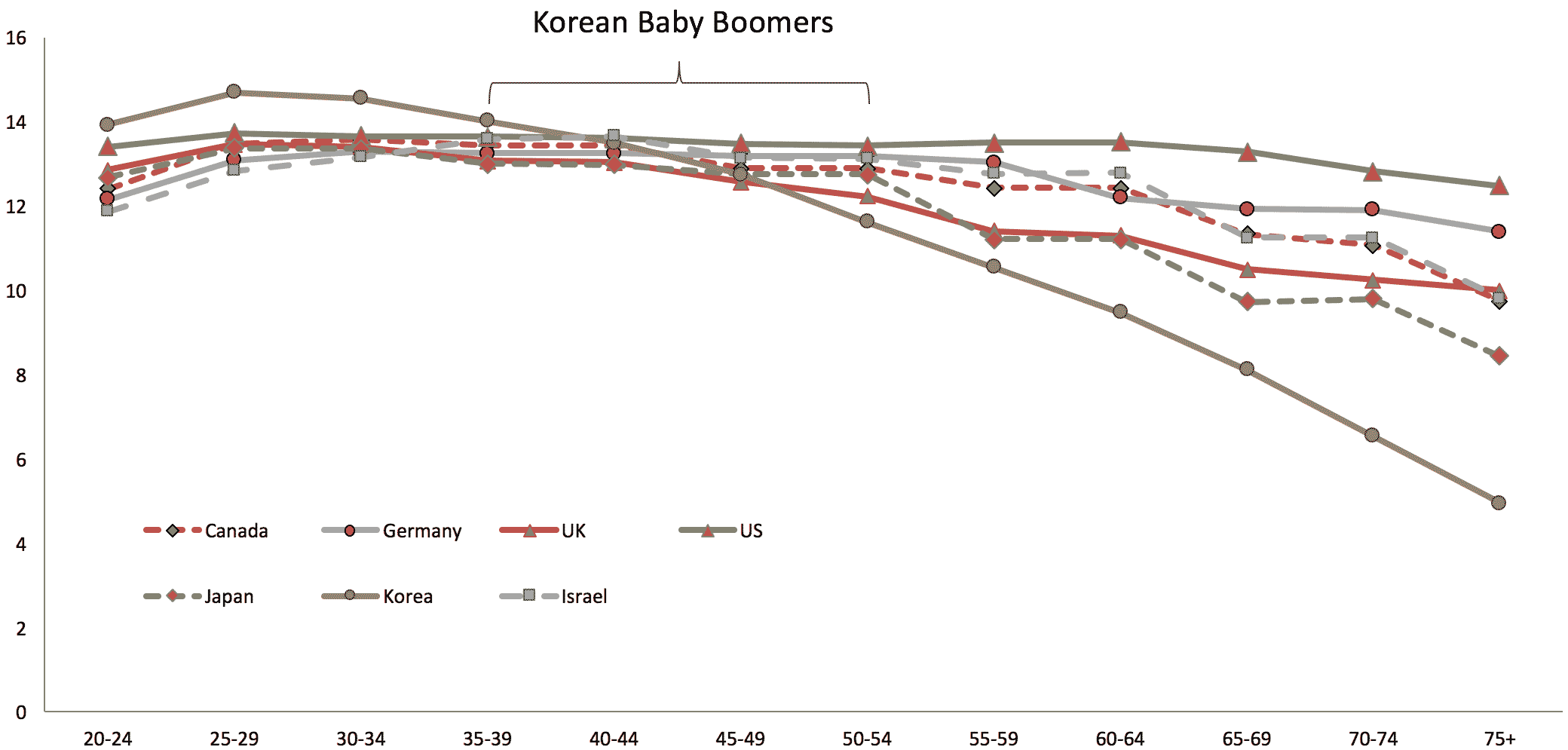
“The aging of Korean baby boomers, who are not just better educated but also possess greater economic and consumption capabilities than previous generations, will shift the business landscape and likely prompt companies to more actively tap the older-age market.”
– Jerald Schiff, former Deputy Director of the Asia and Pacific Department at the IMF
Healthcare & Wellness
Life expectancy of Korean older adults has increased significantly but has outpaced improvements in health. In an attempt to address this gap and improve the health of the older population, the government has adopted proactive, preventive approaches, including subsidizing regular checkups and promoting healthy lifestyles. More recently, the government has strived to supportlife quality and wellness of older adults by building a long-term-care benefit system, with a latest reform in 2016 aimed at improving the system’s efficiency, service coverage, and quality. To take advantage of the country’s advanced IT infrastructure, the government is seeking to harness the power of digital technology and accommodate older people’s rising demand for healthcare.
U-health Advocacy Program
The government’s effort to integrate digital technology into the healthcare system is centered around its U-health Advocacy Program. (“U” stands for “ubiquitous.”) Launched in 2010, the program aims to improve accessibility of healthcare services, especiallyfor older adults who live in remote areas. One major component of the Program is “U-silver services,” which target recuperation of people age 65 and older, enabling online ordering of affordable, age-friendly products, including bedsore preventing mattresses, portable bathtubs, and special diapers, among others. The other two components of the Program, “U-medical services” and “U-wellness services,” are intended to enable easier access to medical treatment services –such as providing prescription services regardless of patients’ location –and a physical checkup without going to a hospital. Although these two components do not target specific age segments, they will greatly benefit the one-third of older Koreans who live in rural areas.
Both the lifespan and healthspan of older people in Korea have improved significantly over the past two decades, catching up with other high-income countries. However, the gap between lifespan and healthspan has increased by nearly one year.
Source: Source: Institute for Health Metrics and Evaluation
Life Expectancy (LE) and Healthy Life Expectancy (HALE) (Ages 60–64; in Years)
